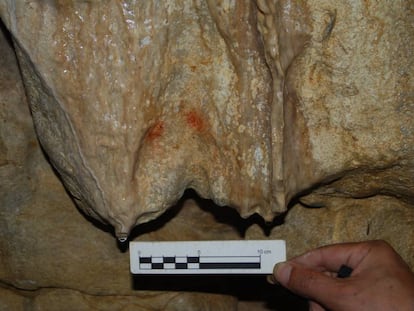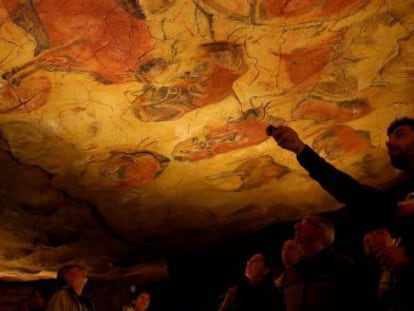Spanish cave art was made by Neanderthals, new test reveals
Uranium-thorium dating system finds that the drawings pre-date modern humans by 20,000 years
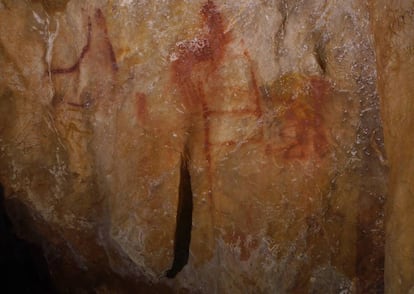
New tests show that a series of enigmatic paintings found in three caves in Spain were made 65,000 years ago, or 20,000 years before modern humans, Homo Sapiens, arrived to the Iberian peninsula. This suggests that Neanderthals must have authored the work, according to a new study that has made the cover of Science magazine.
Five human species coexisted on Earth 80,000 years ago
The implications of the discovery are monumental. This is the first irrefutable evidence that the Neanderthals, who became extinct around 40,000 years ago, had ¡°language, advanced cognition and symbolic thought,¡± explains the Portuguese archaeologist Jo?o Zilh?o, the co-author of the study.
The team analyzed the drawing of a hand outline made 66,700 years ago in a cave in Maltravieso in Spain¡¯s C¨¢ceres province; a mineral deposit covered in paint on the wall of a cave in Adales in M¨¢laga; and a line symbol, similar to a ladder, drawn at least 64,800 years ago in a cave in La Pasiega in Cantabria. These are the oldest known artworks on the planet.
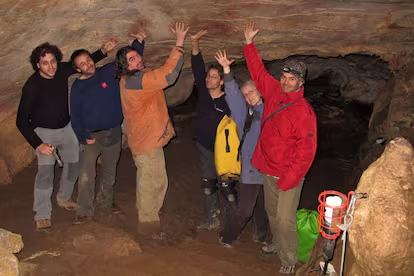
For Zilh?o, the discovery ¡°ends the Genesis' narrative of modern humans leaving Africa as the chosen species.¡± Indeed, the investigator from the University of Barcelona believes that Neanderthals, characterized by a receding forehead and a shorter, stockier body, were in fact Homo Sapiens.

¡°Modern humans are abnormally homogeneous. In the past, the human species was more diverse than it is today, like you see with other current species. The internal variability that we see today in chimpanzees is greater than what we would see in all humans past and present if we considered ourselves just one species,¡± he says. According to the current scientific consensus, 80,000 years ago five human species ¨C Homo Sapiens, Neanderthals, Homo Floresiensis, Homo Erectus and Denisovans coexisted on Earth. But Zilh?o believes that they were all the same species: ¡°in reality, there has never been more than one human species,¡± he says.
¡°Evolution is very complex and I tend to think that today¡¯s modern humans are the result of a build-up that was nourished along its evolutionary path by a network of influences, in this case by other archaic populations like the Neanderthals, who have contributed to our current form, which is what genetics and fossils indicate,¡± says the paleontologist Josefina Zapata from Murcia University.
Zapata partnered with Zilh?o on another investigation that was published simultaneously in the magazine Science Advances. In the study, the scientists discovered that broken and pigmented sea shells found in Los Aviones cave in Cartagena, Murcia dated back 115,000 years ¨C more than twice the 50,000 years calculated in 2010. For the researchers, the results confirm that Neanderthals decorated their bodies with necklaces around 30,000 years before modern humans began to do it in Africa. According to paleontologist Erik Trinkaus from Washington University in San Louis, these studies prove that ¡°Neanderthals and modern humans were behavioral and mental equals.¡±
Thanks to the latest technological advances, scientists were able to use a uranium-thorium dating method to calculate the age of the specimens. The researchers analyzed tiny samples of calcium carbonate taken from the surface of the cave paintings. When these materials are formed by rainfall, traces of uranium accumulate and these are reduced to thorium at a measurable rate. By looking at the proportion of both chemical elements, the precise age of a sample can be calculated.
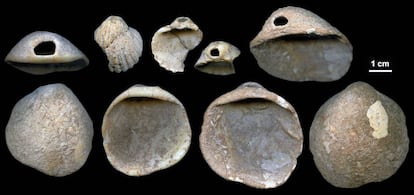
But the director of the National Center of Human Evolution Research, Mar?ia Martin¨®n Torres, does not share the idea that Neanderthals and modern humans were the same species. ¡°The Neanderthals were markedly different in their morphology, in their biological adaptations ¨C for example to completely different climates, in their perfectly distinguishable genetic sequence and even their immune system. And while there was cross-fertilization [sex with offspring between Neanderthals and Sapiens], we also know that there were problems with infertility, which indicates that we were not totally compatible,¡± she says.
Martin¨®n, who did not participate in these latest investigations, believes there are two possibilities to explain the findings: Neanderthals and modern humans independently developed artistic ability ¡°given that both had big brains,¡± or else they learned it from a common ancestor around 500,000 years ago. ¡°Let¡¯s see if the theory that Neanderthals became extinct because they were culturally and symbolically inferior to modern humans finally gets tossed out,¡± she adds.
The prehistorian Marcos Garc¨ªa Diez from Isabel I University in Burgos points to another important finding from the team. In the Ardales cave in M¨¢laga, Neanderthals painted in at least two separate instances with at least 20,000 years between. ¡°They conserved a symbolic tradition for thousands of years. The space, the cave, was also symbolic. Someone must have said: This is our space. This is our shrine.¡±
English version by Melissa Kitson.
Tu suscripci¨®n se est¨¢ usando en otro dispositivo
?Quieres a?adir otro usuario a tu suscripci¨®n?
Si contin¨²as leyendo en este dispositivo, no se podr¨¢ leer en el otro.
FlechaTu suscripci¨®n se est¨¢ usando en otro dispositivo y solo puedes acceder a EL PA?S desde un dispositivo a la vez.
Si quieres compartir tu cuenta, cambia tu suscripci¨®n a la modalidad Premium, as¨ª podr¨¢s a?adir otro usuario. Cada uno acceder¨¢ con su propia cuenta de email, lo que os permitir¨¢ personalizar vuestra experiencia en EL PA?S.
?Tienes una suscripci¨®n de empresa? Accede aqu¨ª para contratar m¨¢s cuentas.
En el caso de no saber qui¨¦n est¨¢ usando tu cuenta, te recomendamos cambiar tu contrase?a aqu¨ª.
Si decides continuar compartiendo tu cuenta, este mensaje se mostrar¨¢ en tu dispositivo y en el de la otra persona que est¨¢ usando tu cuenta de forma indefinida, afectando a tu experiencia de lectura. Puedes consultar aqu¨ª los t¨¦rminos y condiciones de la suscripci¨®n digital.

